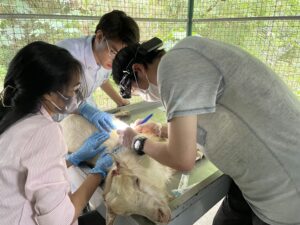Pilot study
"Survey of environmental dynamics of tick borne diseases in the Philippines"
R5 2-1 (R5 AY2023)
| Project Leader | Matoba Naoki (National Cerebral and Cardiovascular Center) |
| Research Project | Survey of environmental dynamics of tick-borne diseases in the Philippines |
| Countries of Study | Philippines |
Outline of Research
Tick-borne diseases such as theileriosis and babesiosis have caused tremendous damage to the livestock industry in the Philippines. Clarifying the actual prevalence of these diseases is an urgent issue. Furthermore, the actual prevalence of the disease in the Philippines, a country with significant trade with Japan, is extremely important for Japanese import quarantine. However, at present, owing to a lack of testing equipment and reagents in the region, the prevalence of these diseases and their routes of transmission are unknown. This study aims to develop a new diagnostic method for tick-borne diseases that is simpler and less costly than conventional methods, enabling researchers in the region to conduct continuous disease surveys. In addition, we utilize this method to conduct an epidemiological study of diseases in the Philippines and elucidate the actual prevalence of these diseases.
Purpose of Research, Its Significance and Expected Results, etc
The objectives of this study are (1) to develop a new test method for tick-borne diseases in the Philippines that is simpler and less costly than conventional methods and (2) to utilize the developed test method to determine the actual prevalence of the infection.
This method involves sampling blood and external parasites, including ticks, from livestock on farms in the Cavite Province, Northern Philippines. The samples obtained will then be used to develop the test using the loop-mediated isothermal amplification (LAMP) method. In addition, molecular biology detection of tick-borne pathogens such as babesia, theileria, and anaplasma in goats will also be carried out using the method developed from the collected samples to investigate the prevalence of tick-borne diseases and the transmission routes of each disease. In this survey, we will focus on piroplasmosis, which is endemic to goats in the Philippines.
The scientific significance of this study is to (1) establish a highly sensitive, low-cost, and simple original diagnostic method for tick-borne diseases in the Philippines and (2) clarify the actual prevalence of these diseases, which remains largely unknown. In particular, piroplasmosis in goats in the Philippines is mostly unknown, not only in terms of prevalence but also in terms of transmission routes, and even the vectors by which the disease is transmitted are not well understood. For these reasons, there is tremendous scientific significance in clarifying the prevalence and transmission routes of tick-borne diseases, such as piroplasmosis, in goats in the Philippines. Clarifying the prevalence of these diseases is of great social significance because the livestock industry is one of the most important industries in the Philippines, and tick-borne diseases have caused tremendous damage to the livestock industry. Clarifying the prevalence of diseases in the Philippines, where trade with Japan is intensely active, has great significance in terms of Japanese import quarantine, as ticks living in Japan can transmit tick-borne diseases prevalent in the Philippines.
The expected benefits of this research include the following: (1) continuous investigation of tick-borne diseases will be possible even in local areas where there is a lack of testing equipment and reagents, and (2) clarification of the actual prevalence of the disease will improve infection control measures in the local livestock industry. This will lead to an improvement in Japanese import quarantine for the above reasons. Furthermore, establishing a research system that local researchers can sustain and that does not rely on external support for research equipment, and reagents will also promote the independent development of local research institutions and the livestock industry and have great social significance for the future.




